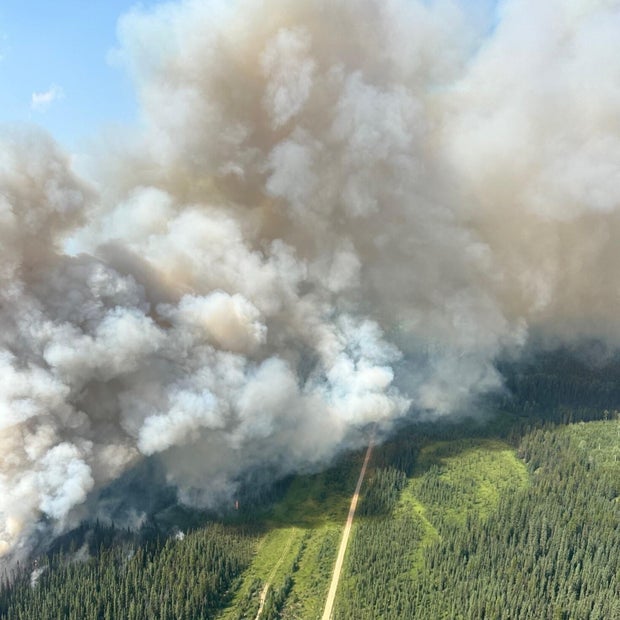Parts of a popular tourist destination in the Canadian Rockies have been “burned to the ground” after a wildfire with tropical storm force winds merged with another fire to burn 89,000 acres, officials said, adding that as much as half of the town may have been severely damaged.
The fires broke out in Alberta, Canada, where they overtook the municipality of Jasper, home to Jasper National Park, the largest national park in the Canadian Rockies and the second-largest dark sky preserve in the world. It started on Monday, when Parks Canada said it was responding to multiple fires. By the next day, Jasper and Jasper National Park had been evacuated, with officials focusing on two blazes – the North Wildfire and the South Wildfire.
“The storm was ferocious – the skies went dark and there were whipping winds, fierce rain and lightning,” BBC journalist Wendy Hurrell, who had been in the national park when the fires began, said. “…It will be a very long time before [Jasper] will recover. It’s utterly devastating for them all and my heart is breaking.”
ALBERTA WILDFIRE/HANDOUT/Anadolu via Getty Images
“Consistently high and gusty” winds caused the fires to spread and grow from the confines of the park to the town itself. On Wednesday night, air quality “deteriorated to the point that wildland firefighters and others without self contained breathing apparatuses needed to evacuate” and the fires had merged, officials said.
“It [was] just a monster at that point,” Pierre Martel, director for Parks Canada’s national fire management program, told the BBC. “There are no tools we have in our tool box to deal with it.”
Thursday saw wind gusts as high as 62 miles per hour – strong enough to be considered a tropical storm had it been a cyclone – and the North and South fires had combined with the nearby Utopia Wildfire, which had almost been contained before the merge. At one point, flames were as high as 328 feet, an official said, according to BBC.
In its latest update, town officials wrote on Facebook that the Jasper Wildfire Complex has burned an estimated 89,000 acres of land, although accurate mapping “has been challenging” due to strong winds, extreme fire behavior, smoke and an inability for aircraft to fly safely.
Thick cloud cover also made satellite imaging difficult on Thursday. Both the town and the national park are under evacuation orders.
“This is the worst nightmare for any community,” Alberta Premier Danielle Smith said during a news conference on Thursday, adding that “potentially 30 to 50%” of buildings had been destroyed.
Canadian talk show host Ryan Jespersen said “there are no words” to describe the damage in Jasper. He posted a video of the damage, showing ashen skies and ground with dead trees and the charred remains of homes and cars. Many buildings in the video are shown to be almost completely gone, with nothing but a few steps remaining in front of nothing but air.
“Jasper is burned to the ground,” he said on social media.
The area saw some relief on Thursday night when temperatures cooled and it started to rain, which the government says will reduce fire behavior for 72 hours. During that time, crews will work to “make as much progress as possible to suppress the wildfire and reduce further spread.” However, officials said that warm weather is expected to resume, increasing the fire’s activity once again.
JASPER NATIONAL PARK /HANDOUT/Anadolu via Getty Images
The same day the fires broke out in Alberta on Monday, Earth had its hottest day ever measured – breaking a record set just hours before. The hotter the planet gets, partially driven by the use of fossil fuels, the more likely areas are to experience the conditions that fuel fires and cause them to rapidly spread – high heat, low humidity, strong winds and dry vegetation.
During Thursday’s press conference, Premier Smith fought back tears and struggled to speak, emotional over the “wall of flames” that had overtaken the town and park that are “a source of pride” for the province, “with some of the most beautiful scenery in the world.”
“Our grandparents visited to experience the majesty of this place, with its mountains and lakes and meadows. They took our parents, who then took us to this special spot that they’d spent time in as children,” she said. “And now we take our own kids and our own loved ones and visitors from around the world to feel that same feeling that you get with your first glimpse of the mountains on the horizon – a feeling that even though you’ve just left home, you’re coming home.”
On its website, Tourism Jasper asked for “patience and grace as many of our residents and businesses navigated this loss and turn to the future rebuilding of our community.”
“Maybe the right words will come eventually. Maybe once the dust settles, and the rain falls, and we have an accurate assessment of the damage, maybe then we’ll be able to fully express our sadness about Jasper’s recent tragedy,” the department said in an emotional note on its website. “…Our mountains have stood tall for millions of years, and Jasper will stand tall through this.”



